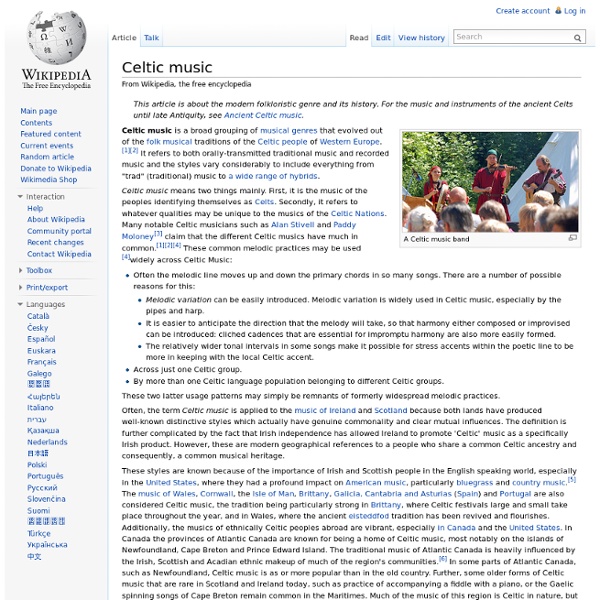Celtic music

Folk music of Ireland
Traditional music sessions are commonplace in public houses throughout Ireland The folk music of Ireland (also known as Irish traditional music, Irish trad, Irish folk music, and other variants) is the generic term for music that has been created in various genres in Ireland. Irish traditional music has survived more strongly against the forces of cinema, radio and the mass media than the indigenous folk music of most European countries. Music for singing[edit] Like all traditional music, Irish folk music has changed slowly. Unaccompanied vocals are called sean nós ("in the old style") and are considered the ultimate expression of traditional singing. Non-sean-nós traditional singing, even when accompaniment is used, uses patterns of ornamentation and melodic freedom derived from sean-nós singing, and, generally, a similar voice placement. Caoineadh Songs[edit] Caoineadh/kˠi:nʲɪ/ is Irish for a lament, a song which is typified by lyrics which stress sorrow and pain. Music for dancing[edit]
The Chieftains
The Chieftains are a traditional Irish band formed in Dublin in November 1962, by Paddy Moloney, Sean Potts and Michael Tubridy. The band had their first rehearsals at Moloney's house, with Tubridy, Martin Fay and David Fallon. Their sound, which is almost entirely instrumental and largely built around uilleann pipes, has become synonymous with traditional Irish music and they are regarded as having helped popularise Irish music across the world.[1] Paddy Moloney came out of Ceoltóirí Chualann, a group of musicians who specialised in instrumentals, and sought to form a new band. The group remained only semi-professional up until the 1970s, by then they had achieved great success in Ireland and the United Kingdom. Name[edit] Career[edit] In 2012, they celebrated their 50th anniversary with an ambitious album and tour. Collaborations[edit] Paddy Moloney pictured with Bob Dylan, who is a fan of the band's work. Performed with Canadian astronaut Cmdr. Success and legacy[edit] Dr. Personnel[edit]
The Celts and Romans - Interactive History Resources
IRISH LITERATURE, MYTHOLOGY, FOLKLORE, AND DRAMA
Irish Writers OnlineIrish PlayographyStudy Ireland: Poetry - BBCIrish Women Writers - M. OckerbloomIreland Literature GuidePoetry Ireland / Éigse ÉireannEarly Irish Lyric Poetry - Kuno MeyerSonnets from Ireland - E. BlomquistColum's Anthology of Irish Verse - Bartleby.comBREAC - Digital Journal of Irish Studies Medieval Celtic ManuscriptsThe Book of KellsCarmina GadelicaCELT Irish Electronic Texts Irish Writers OnlineIreland Literature ExchangeBibliography of 19th-c. Jonathan SwiftJonathan Swift ArchiveJonathan Swift Biography - IncompetechGulliver's Travels - U. Bram StokerDraculaBram Stoker Biography - Classic Literature LibraryBram Stoker's Dracula - Carstens smith Oscar WildeThe Official Home Page of Oscar WildeWilde Biography - BBCOscar Wilde OnlineCELT: Oscar WildePoetry of Oscar Wilde - Bartleby.com George Bernard ShawShaw Biography - C. William Butler YeatsYeats Biography - Poetry FoundationCollected Poems - W. Donn ByrneByrne Biography - J. Fine Art The Faery Harper Oisín
Related:
Related:



